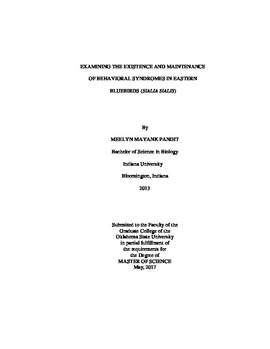| dc.description.abstract | Behavioral syndromes are suites of correlated behaviors that can constrain behavioral expression. Constrained behaviors in environments with high levels of human development, which expose individuals to multiple novel contexts, may lead to the expression of suboptimal behaviors that can have fitness implications. One particular aspect of human development that affects animal behavior, specifically avian behavior, is anthropogenic noise. Past studies demonstrated that anthropogenic noise can affect vocalizations, but few studies have examined how anthropogenic noise may affect behavioral syndromes. This study examined the existence of behavioral syndromes in eastern bluebirds (Sialia sialis) and tested if syndrome strength varied across a gradient of anthropogenic noise. During the breeding season, I conducted feed watches, heterospecific simulated territorial intrusions, and novel object trials on adult bluebirds to measure parental care, aggression, and boldness, respectively. I also recorded ambient noise levels as a measurement of anthropogenic noise. Males and females had behavioral syndromes between aggression and boldness, while only males had a behavioral syndrome between parental care and boldness, and only females had a behavioral syndrome between parental care and aggression. Noisy habitats slightly weakened the relationship between aggression and boldness, as well as the relationship between parental care and aggression in female bluebirds, while anthropogenic noise had no significant impact on male behavioral syndromes. Behavioral syndromes may potentially explain the repeatable nest defense aggression behavior in female eastern bluebirds, while selection may favor more plastic aggression in males. Anthropogenic noise may weaken correlated behaviors in female bluebirds, indicating that anthropogenic disturbance may uncouple behavioral syndromes. To determine the full impact of anthropogenic noise on behavioral expression, future studies should examine the effects of experimentally elevated noise levels on individual behavioral phenotypes. | |
